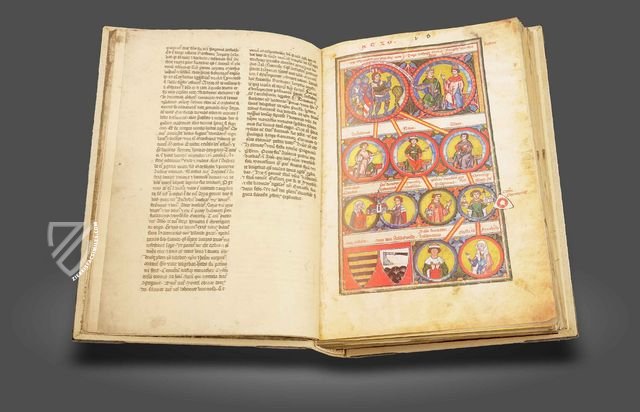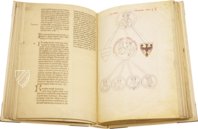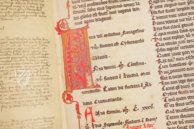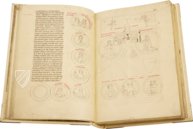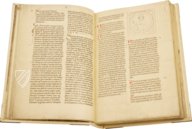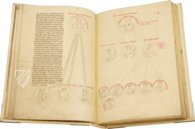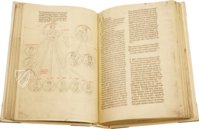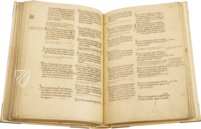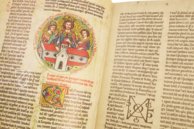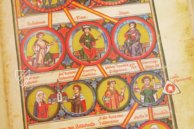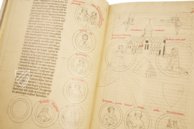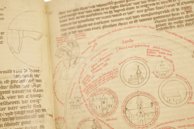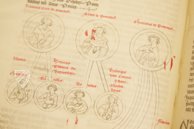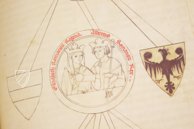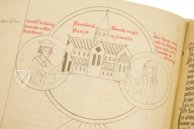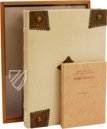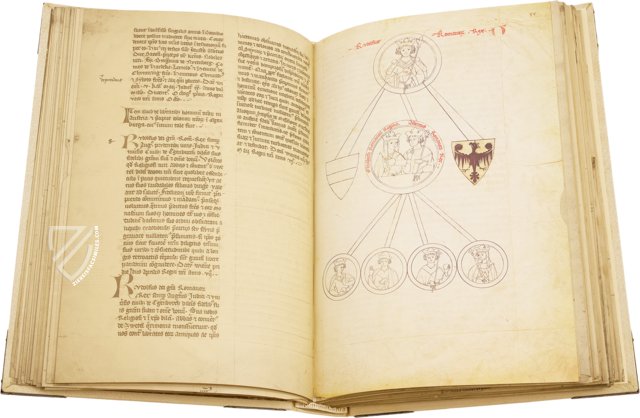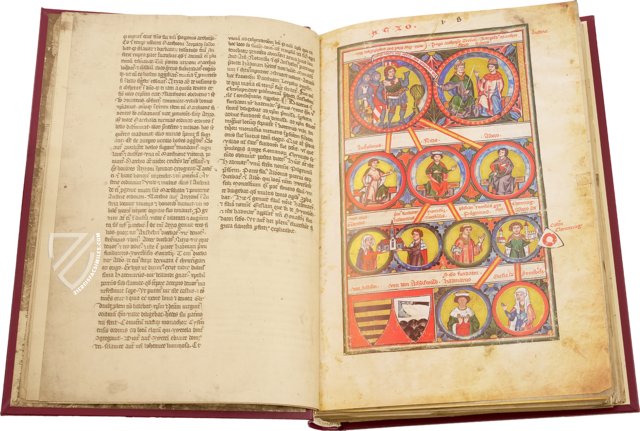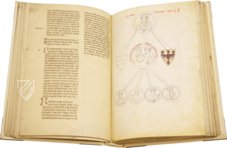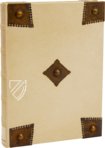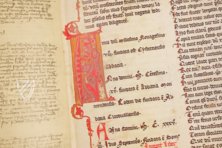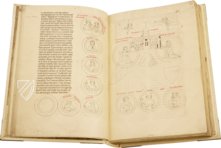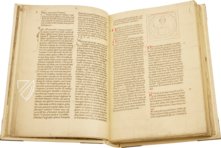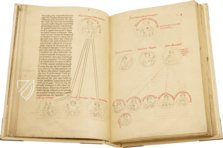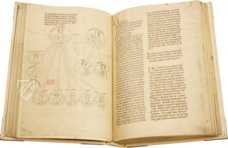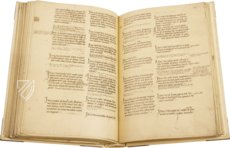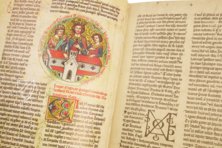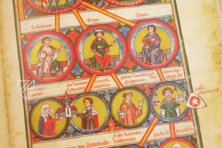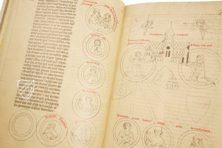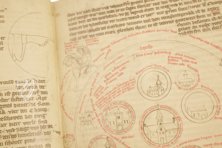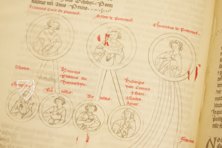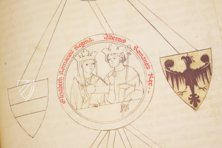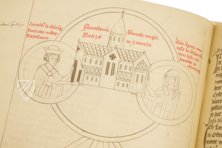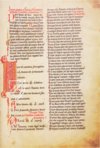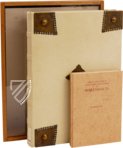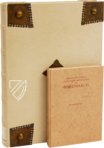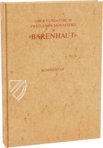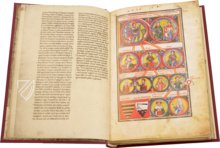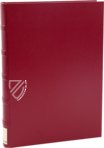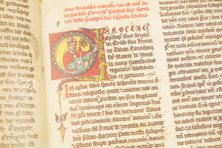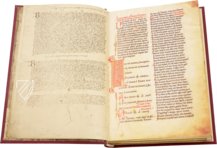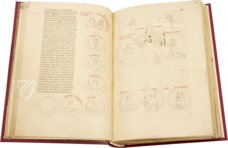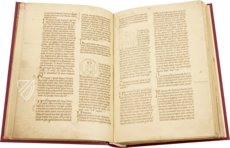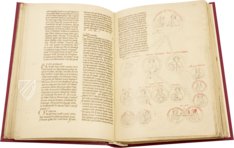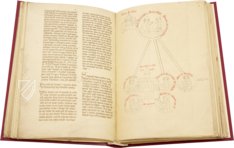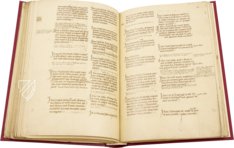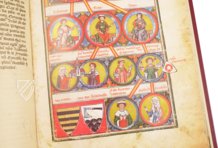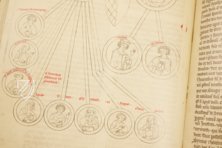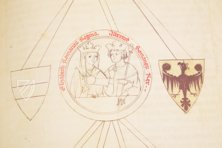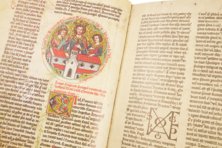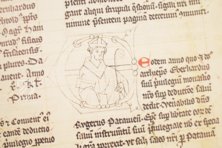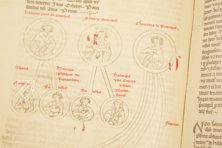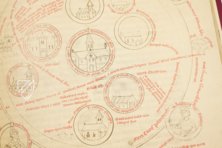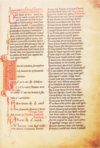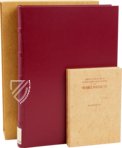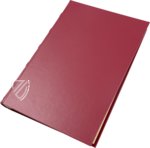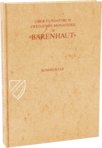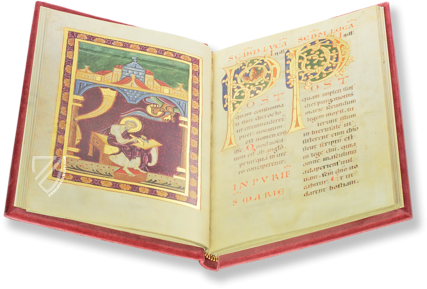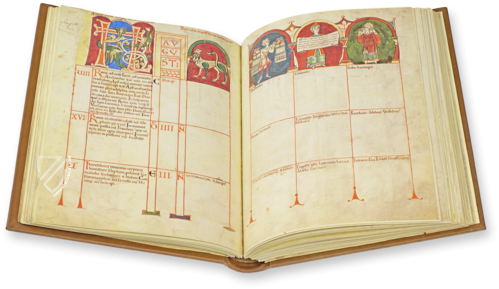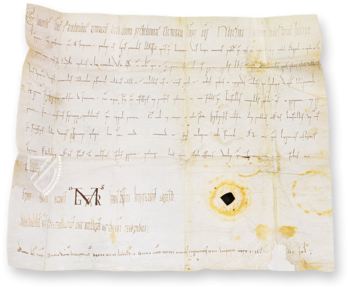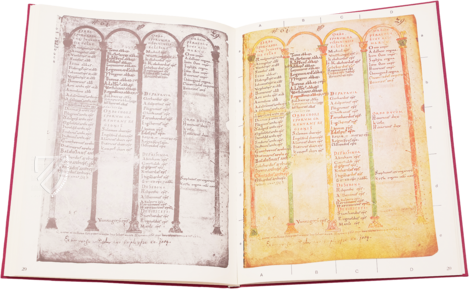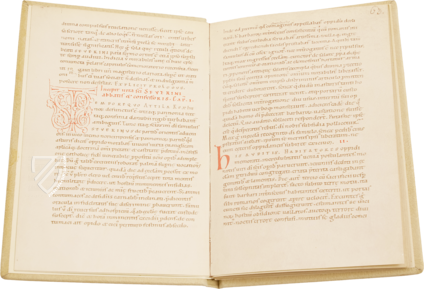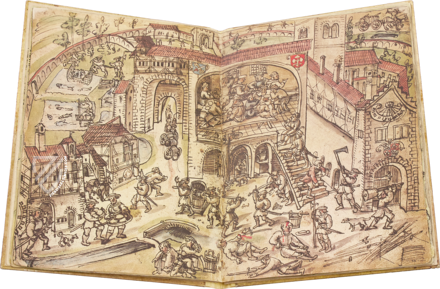Book of Zwettl "Bear Skin"
(1,000€ - 3,000€)
Monks served many functions in medieval society, one of them was to act as chroniclers, recording contemporary events for posterity. The Book of Zwettl, also called "Bear Skin" because of its binding, is among the primary Austrian sources of the early 14th century, both in historic and art historic aspects. The work revolves around the Kuenring dynasty and Zwettl Abbey, which they patronized for centuries. Written in Latin and Middle High German, both the contents and the decorative apparatus of the codex indicate that the Cistercians not only wished to document the evolution of their territories and the question of tithe but also to ascribe an important place in history to the abbey.
Book of Zwettl "Bear Skin"
The Book of Zwettl, also called "Bear Skin" because of its binding, is among the primary Austrian sources of the early 14th century, both in historic and art historic aspects. The enormously rich source material gathered not only informs us about the history of the monastery itself but, beyond that, about the history of the sovereignty and possession of the Austrian lands. At the center of this work stands the Kuenring dynasty who founded the Monastery of Zwettl and left their mark on an eventful era of Lower Austrian regional history. The great significance of this manuscript lies in the effort made by its author to classify the wealth of source material according to a well thought out system. Judging from its appearance, the book constitutes a luxury manuscript and thus a very rare example of a collection destined for practical use which was still lavishly decorated. Its worth as a representative state codex is underlined by numerous feather drawings and opaque color paintings of excellent quality and topped by a fascinating full-page miniature in luminous colors which presents the genealogical tree of the Kuenrings in medallions on a golden ground. The manifold initials and picture medallions make this manuscript a valuable work of art.
The Decorative Apparatus
The feather drawings and opaque color paintings probably go back to an anonymous artist from a secular workshop that must have been located in the surroundings of Vienna. The initials and figural representations melt in perfect harmony with the text and were obviously created at the same time. Although the text is written in Latin, it also contains sections in Middle High German and is the work of several hands. It is decorated with numerous ornamental letters, often outlined in red, as well as with red chapter titles and rubrics, allowing the reader to rapidly find the section he is looking for. The rubrication of the codex was obviously incumbent to the Cistercians who had a very profound knowledge of the subject. The term of "Bear Skin" was commonly used from an early stage for the Book of Zwettl on account of its binding, which, contrary to general assumptions, was not made from the skin of a bear but from that of a male pig, known colloquially in Austria as a "sow bear".
An Important Historic Monument
We know of very few manuscripts from the early 14th century whose materiality, contents, and decoration would match the Book of Zwettl. With the script and decoration of a luxury book, this work is a late example for the combination of historical narrative and documentary source material, as was common around 1200. The process of organizing the rich stocks of the monastery including documents and other source material began around 1315 and in combination with invaluable oral sources and traditions led to the creation of a truly sumptuous manuscript. The result was a comprehensive historical work which not only describes the most interesting history of Zwettl Abbey but also an account of the founding family, the Kuenrings, thus constituting a noteworthy contemporary document of Lower Austrian regional history. The establishment of a systematic system was first initiated by abbot Ebro. His successors Otto I and Gregory used this preliminary work for their own purposes and Gregory is considered to be the original author of this large format codex. The manuscript contains copies of ancient records of both historical and genealogical importance, the book of rent and two alphabetic indices for easy use. Both the contents and the decorative apparatus of the codex indicate that the Cistercians not only wished to document the evolution of their territories and the question of tithe but also to ascribe an important place in history to the abbey. The codex was not least conceived as evidence of a political, economic, and cultural heritage. This intended representative purpose is clearly visible in the rich embellishment of the work. As a result, the Cistercians were endowed with a valuable book which was indispensable to any important center of learning.
Codicology
- Alternative Titles
- Stifterbuch des Klosters Zwettl - "Bärenhaut"
Liber Fundatorum - Size / Format
- 394 pages / 48.5 × 33.5 cm
- Origin
- Austria
- Date
- 1327/1328
- Epochs
- Style
- Illustrations
- 1 full-page miniature, numerous initial letters, medaillons and pen drawings
- Content
- History of the Kuenring dynasty and Zwettl Abbey, which they patronized for centuries
Book of Zwettl "Bear Skin"
Portrait Medallion of Three Noblemen
These are the three most important figures associated with the foundation of Zwettl Abbey. Wearing a ducal crown on the left, Leopold, Duke of Bavaria and Margrave of Austria, is gesturing as though he were having a discussion with Hadmar I of Kuenring (right), who actually founded the abbey. In the center, King Conrad III of Germany is drawn larger than the other two figures to emphasize his status and is literally embracing the abbey as Leopold and Hadmar rest their hands on its roof.
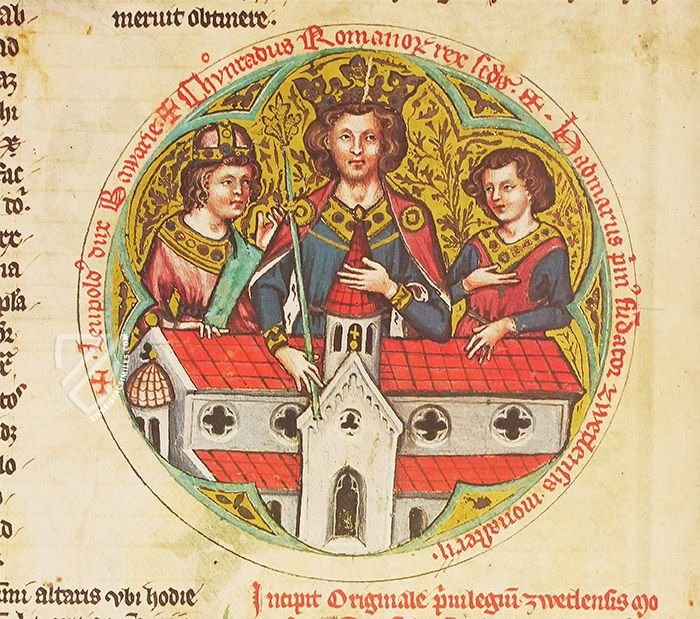
Book of Zwettl "Bear Skin"
The Kuenring Family Tree
Divided into 4 horizontal strips, these 11 miniatures are presented in red and blue frames with gold leaf backgrounds. The large medallion at the top-left shows Azzo of Gobatsburg, the progenitor of the Kuenringers, accompanied by three squires. On the right, Archbishop Poppo of Trier and Margrave Leopold II of Austria are wrongly identified as brothers.
The second strip of medallions has portraits of Azzo’s three sons: Anshalm, Nizzo, and Albero. On the left in the third strip, Hadmar I and his wife Gertrude are shown holding up a model of Zwettl Abbey and Halmar is described as a pious founder. Their line ends here because Hadmar died without issue a year after he founded the abbey in 1137 and the lordship passed to his cousin Albero III.
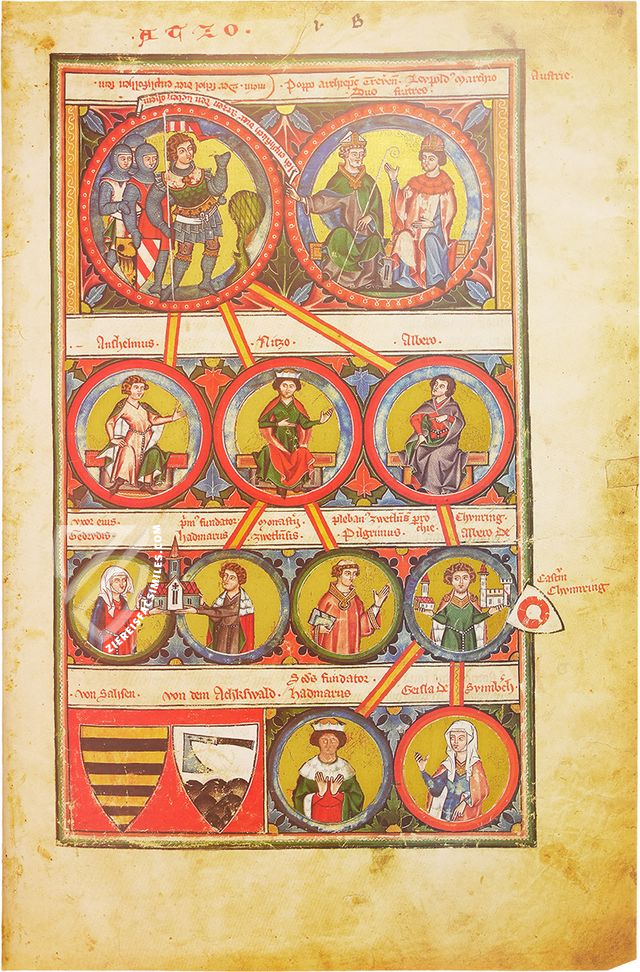
#1 Stifterbuch des Klosters Zwettl ("Bärenhaut") (Luxury Edition)
Language: German
J. Rössl, Vienna, 144 pp. with 14 illustrations.
The commentary was written by Joachim Rössl and contains a description of the codicological examination and the contents of the manuscript. It also comprises a record of copied documents and observations concerning the scribes and the illuminators of the codex.
(1,000€ - 3,000€)
#2 Stifterbuch des Klosters Zwettl ("Bärenhaut") (Normal Edition)
Language: German
J. Rössl, Vienna, 144 pp. with 14 illustrations.
The commentary was written by Joachim Rössl and contains a description of the codicological examination and the contents of the manuscript. It also comprises a record of copied documents and observations concerning the scribes and the illuminators of the codex.
(1,000€ - 3,000€)
- Treatises / Secular Books
- Apocalypses / Beatus
- Astronomy / Astrology
- Bestiaries
- Bibles / Gospels
- Chronicles / History / Law
- Geography / Maps
- Saints' Lives
- Islam / Oriental
- Judaism / Hebrew
- Single Leaf Collections
- Leonardo da Vinci
- Literature / Poetry
- Liturgical Manuscripts
- Medicine / Botany / Alchemy
- Music
- Mythology / Prophecies
- Psalters
- Other Religious Books
- Games / Hunting
- Private Devotion Books
- Other Genres
- Afghanistan
- Armenia
- Austria
- Belgium
- Colombia
- Croatia
- Czech Republic
- Denmark
- Egypt
- Ethiopia
- France
- Germany
- Hungary
- India
- Iran
- Iraq
- Israel
- Italy
- Japan
- Luxembourg
- Mexico
- Morocco
- Netherlands
- Peru
- Poland
- Portugal
- Russia
- Serbia
- Spain
- Sri Lanka
- Sweden
- Switzerland
- Syria
- Turkey
- Ukraine
- United Kingdom
- United States
- Uzbekistan
- Aboca Museum
- Ajuntament de Valencia
- Akademie Verlag
- Akademische Druck- u. Verlagsanstalt (ADEVA)
- Aldo Ausilio Editore - Bottega d’Erasmo
- Alecto Historical Editions
- Alkuin Verlag
- Almqvist & Wiksell
- Amilcare Pizzi
- Andreas & Andreas Verlagsbuchhandlung
- Archa 90
- Archiv Verlag
- Archivi Edizioni
- Arnold Verlag
- ARS
- Ars Magna
- ArtCodex
- AyN Ediciones
- Azimuth Editions
- Badenia Verlag
- Bärenreiter-Verlag
- Belser Verlag
- Belser Verlag / WK Wertkontor
- Benziger Verlag
- Bernardinum Wydawnictwo
- BiblioGemma
- Biblioteca Apostolica Vaticana (Vaticanstadt, Vaticanstadt)
- Bibliotheca Palatina Faksimile Verlag
- Bibliotheca Rara
- Boydell & Brewer
- Bramante Edizioni
- Brepols Publishers
- British Library
- C. Weckesser
- Caixa Catalunya
- Canesi
- CAPSA, Ars Scriptoria
- Caratzas Brothers, Publishers
- Carus Verlag
- Circulo Cientifico
- Club Bibliófilo Versol
- Club du Livre
- CM Editores
- Collegium Graphicum
- Collezione Apocrifa Da Vinci
- Comissão Nacional para as Comemorações dos Descobrimentos Portugueses
- Coron Verlag
- Corvina
- CTHS
- D. S. Brewer
- De Agostini/UTET
- De Schutter
- Deuschle & Stemmle
- Deutscher Verlag für Kunstwissenschaft
- DIAMM
- Droz
- E. Schreiber Graphische Kunstanstalten
- Ediciones Boreal
- Ediciones Grial
- Ediclube
- Edições Inapa
- Edilan
- Editalia
- Edition Georg Popp
- Edition Leipzig
- Edition Libri Illustri
- Editiones Reales Sitios S. L.
- Éditions de l'Oiseau Lyre
- Editions Medicina Rara
- Editorial Casariego
- Editorial Mintzoa
- Editrice Antenore
- Editrice Velar
- Edizioni Edison
- Egeria, S.L.
- Eikon Editores
- Electa
- Enciclopèdia Catalana
- Eos-Verlag
- Ephesus Publishing
- Eugrammia Press
- Extraordinary Editions
- Fackelverlag
- Facsimila Art & Edition
- Facsimile Editions Ltd.
- Facsimilia Art & Edition Ebert KG
- Faksimile Verlag
- Feuermann Verlag
- Folger Shakespeare Library
- Franco Cosimo Panini Editore
- Friedrich Wittig Verlag
- Fundación Hullera Vasco-Leonesa
- G. Braziller
- Gabriele Mazzotta Editore
- Gebr. Mann Verlag
- Gesellschaft für graphische Industrie
- Getty Research Institute
- Giovanni Domenico de Rossi
- Giunti Editore
- Graffiti
- Grafica European Center of Fine Arts
- Guido Pressler
- Guillermo Blazquez
- H. N. Abrams
- Harrassowitz
- Helikon
- Hendrickson Publishers
- Henning Oppermann
- Herder Verlag
- Hes & De Graaf Publishers
- Hoepli
- Hortus Deliciarum
- Houghton Library
- Hugo Schmidt Verlag
- Idion Verlag
- Il Bulino, edizioni d'arte
- ILte
- Imago
- Insel Verlag
- Instituto de Estudios Altoaragoneses
- Instituto Nacional de Antropología e Historia
- Istituto dell'Enciclopedia Italiana - Treccani
- Istituto Ellenico di Studi Bizantini e Postbizantini
- Istituto Geografico De Agostini
- Istituto Poligrafico e Zecca dello Stato
- Italarte Art Establishments
- J. Thorbecke
- Jan Thorbecke Verlag
- Johnson Reprint Corporation
- Jugoslavija
- Karl W. Hiersemann
- Kasper Straube
- Kaydeda Ediciones
- Konrad Kölbl Verlag
- Kurt Wolff Verlag
- La Liberia dello Stato
- La Linea Editrice
- La Meta Editore
- Lambert Schneider
- Landeskreditbank Baden-Württemberg
- Leo S. Olschki
- Les Incunables
- Library of Congress
- Libreria Musicale Italiana
- Lichtdruck
- Lito Immagine Editore
- Lumen Artis
- Lund Humphries
- M. Moleiro Editor
- Maison des Sciences de l'homme et de la société de Poitiers
- Manuscriptum
- Maruzen-Yushodo Co. Ltd.
- MASA
- McGraw-Hill
- Militos
- Millennium Liber
- Müller & Schindler
- National Library of Wales
- Neri Pozza
- Nova Charta
- Oceanum Verlag
- Odeon
- Orbis Mediaevalis
- Orbis Pictus
- Österreichische Staatsdruckerei
- Oxford University Press
- Pageant Books
- Parzellers Buchverlag
- Patrimonio Ediciones
- Pattloch Verlag
- PIAF
- Pieper Verlag
- Plon-Nourrit et cie
- Prestel Verlag
- Princeton University Press
- Prisma Verlag
- Priuli & Verlucca, editori
- Pro Sport Verlag
- Propyläen Verlag
- Pytheas Books
- Quaternio Verlag Luzern
- Reales Sitios
- Recht-Verlag
- Reichert Verlag
- Reichsdruckerei
- Riehn & Reusch
- Roberto Vattori Editore
- Rosenkilde and Bagger
- Roxburghe Club
- Salerno Editrice
- Sarajevo Svjetlost
- Schöck ArtPrint Kft.
- Scolar Press
- Scrinium
- Scripta Maneant
- Scriptorium
- Siloé, arte y bibliofilia
- SISMEL - Edizioni del Galluzzo
- Sociedad Mexicana de Antropología
- Sorli Ediciones
- Stainer and Bell
- Styria Verlag
- Sumptibus Pragopress
- Szegedi Tudomànyegyetem
- Taberna Libraria
- Tarshish Books
- Taschen
- Tempus Libri
- Testimonio Compañía Editorial
- Thames and Hudson
- The Clear Vue Publishing Partnership Limited
- The Facsimile Codex
- The Folio Society
- The Marquess of Normanby
- The Richard III and Yorkist History Trust
- Tip.Le.Co
- TouchArt
- TREC Publishing House
- TRI Publishing Co.
- Trident Editore
- Typis Regiae Officinae Polygraphicae
- Universidad de Granada
- University of California Press
- University of Chicago Press
- Urs Graf
- Vallecchi
- Van Wijnen
- VCH, Acta Humaniora
- VDI Verlag
- Verlag für Regionalgeschichte
- Verlag Styria
- Vicent Garcia Editores
- W. Turnowsky
- Wiener Mechitharisten-Congregation (Wien, Österreich)
- Wissenschaftliche Buchgesellschaft
- Xuntanza Editorial
- Zollikofer AG

